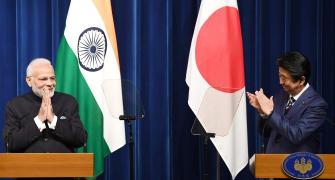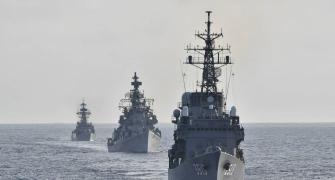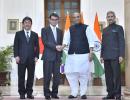The compulsion behind India and Japan to deepen security cooperation is in response to China's growing political and economic clout and its assertive behaviour in disputed areas.
This has been the key driver for bringing both India and Japan closer in the domain of security cooperation, explains Dr Rajaram Panda.

On August 20, 2024, India and Japan held the 2+2 dialogue in New Delhi.
Defence Minister Rajnath Singh and External Affairs Minister S Jaishankar held the dialogue with their Japanese counterparts Minoru Kihara and Yoko Kamikawa and reviewed the bilateral ties besides exploring new initiatives to further strengthen the engagements between the two countries.
This was the third edition of the 2+2 Ministerial Dialogue between the two countries.
The broader objective of this initiative is to further deepen bilateral security and defence cooperation and bring greater depth to the special strategic and global partnership between the two countries.
A press release by the Japanese foreign ministry rightly observed that this high-level meeting underscored the deepening ties between the two nations amidst a complex global and regional environment.
They also exchanged views on regional and global issues of mutual interest and agreed on an open Indo-Pacific region.
Jaishankar said that in the last decade, the relationship between the two countries has assumed the form of a special strategic and global partnership.
He remarked: 'The logic of this evolution is our expanding interest and growing activities. As we both step forward into a more volatile and unpredictable world, there is a need for reliable partners with whom there are substantial convergences. As a result, we have consciously sought to facilitate each other's endeavours, comprehend each others' objectives...'
the strategic partnership between India and Japan will continue to grow as both the countries embrace mutuality and display sensitivity, Jaishankar added.
The India-Japan 2+2 ministerial dialogue reaffirmed the commitment to a free, open, and rules-based Indo-Pacific.
The talks, which came against the backdrop of increasing military assertiveness by China in the region, were a natural extrapolation from India's Act East Policy.
Echoing Jaishankar's sentiment, Rajnath Singh said that the bilateral relations between the two nations have increased in all areas.
He underlined that the defence sector has emerged as an important pillar in the relationship between the two countries.
The defence minister reminded his Japanese counterpart that India has taken a policy decision to make India a developed and transformed nation, Vikshit Bharat, by 2047, on the completion of 100 years of India's independence.
To achieve this goal, building domestic defence infrastructure to enhance capabilities is a very important part of this vision.
The defence minister underlined that partnership with Japan in the field of defence technology and industry will play an important role in the completion of this vision of India.

The first edition of the India-Japan 2+2 Ministerial Dialogue was held in India in 2019 while the second one took place in Japan in 2022.
The 2+2 dialogue with Japan was initiated to further deepen bilateral security and defence cooperation and bring greater depth to the special strategic and global partnership between the two countries.
India has the 2+2 ministerial format of dialogue with very few countries including the US, Australia and Russia.
As regards Japan, it has similar dialogue arrangement with the US and the Philippines, besides defence trilateral with the US and South Korea.
By aligning with their respective key allies, both India and Japan are expanding their strategic outreach through 2+2 dialogues, Quad, East Asia Summit and pushing the geoeconomic agenda with the launch of the Crisis Response Network under the Indo-Pacific Economic Framework (IPEF).
So, what did the third edition of the 2+2 dialogue achieve in concrete terms, at least from India's point of view?
It allowed India to sharpen its understanding of Japan's regional threat assessment and provided an opportunity to assess the future trajectory of India-Japan ties after Prime Minister Kishida Fumio departs the scene and Japan shall have a new prime minister at the helm.

In a separate meeting with Prime Minister Narendra Modi, besides underlining the need to strengthen the strategic partnership between the countries, discussion also focused on potential areas for closer cooperation, including critical minerals, semiconductors, and defence manufacturing.
Besides reviewing progress on various bilateral projects, notably the Mumbai-Ahmedabad high-speed rail project, the leaders exchanged views on regional and global issues of mutual interest.
The needs to enhance economic cooperation and strengthen people-to-people ties were also stressed.
Modi expressed optimism about a productive visit to Japan for the next summit between the two prime ministers later in 2024.
As regards the response from the Japanese side, Kamikawa emphasised the importance of the 10-year-old Japan-India Special Strategic and Global Partnership and stressed the need to strengthen security cooperation, a key pillar of the partnership.
On his part, Kihara acknowledged the steady progress in bilateral security cooperation and requested continued collaboration.
The highlight of the discussion was on deepening cooperation in technical fields, including the defence industry and semiconductors.
The discussions reinforced the commitment to a robust and mutually beneficial partnership, setting the stage for future collaboration on regional and global challenges.
Overall, the discussion showcased the enduring and expanding strategic alignment between the two countries.
As it transpired, the 2+2 ministerial format of dialogue that India has with Japan is in addition to similar dialogues with the US, Australia and Russia.
India has felt the need for reliable partners with whom there are substantial convergences in the volatile and unpredictable world.
For India, partnering with Japan is crucial to ensure freedom, inclusivity and transparency in the Indo-Pacific.
As expected, defence emerged as one of the most important pillars in the India-Japan relationship.

The most striking aspect to note in the 2+2 dialogue was that keeping China in mind, both India and Japan decided to upgrade pact to counter security challenges.
This included laying the groundwork for providing New Delhi with advanced naval antennae and exploring the repair of Japanese warships in India.
This was in continuation with the 2008 Joint Declaration on Security Cooperation 'to reflect contemporary priorities and be responsive to contemporary security challenges facing them'.
Both Jaishankar and Kamikawa underlined the 'increasingly severe' international security environment as a key factor in updating the document and reaffirmed a 'strong determination' to work toward 'creating new solutions together'.
The earlier security declaration has acted as a roadmap for building up security ties and the updates were to focus on deepened bilateral cooperation in the fields of space and cybersecurity.
It will likely be formalised to coincide with a visit to Japan by Prime Minister Modi by the end of the year.
Both sides agreed to upscale their defence industrial collaborations.
Both lauded progress toward a long-rumoured Japanese "transfer" to India of the Unified Complex Radio Antenna (UNICORN) and related technologies.
The cutting edge radar antennas, part of the Nora-50 integration mast, are being installed on some of the Maritime Self-Defense Forces' advanced Mogami-class frigates. Their shape is designed to reduce the radar cross section, which gives it stealth capability.
However, it is unclear whether the antennae would be sold or donated but by supplying them, Japan hopes to open the door to more defence collaboration, including potential exports.
This may be read in the light of Tokyo's recent decision to ease its strict defense export guidelines as part of a bid to build up its domestic defence industry.
There were some ambiguities in the actual plan of execution, however.
Though both sides agreed to accelerate 'future cooperation in defense equipment and technology', no details were available on what this would entail.
Kihara's statement at the press conference that Japan would deepen defence equipment and technical cooperation with India by using the transfer of the latest type of radar left much to speculation.

Both sides also explored future cooperation in the area of ship maintenance in India between the MSDF and the Indian Navy.
India will soon serve as a maintenance hub for US warships in the Indo-Pacific.
Three Iocal shipyards have signed deals with the US navy, which, unlike the MSDF, operates globally.
A similar Japan-India deal would suggest that the MSDF shall be positioned for missions farther afield.
It remains unclear however if this would mean a greater naval presence in the Indian Ocean.
The compulsion behind India and Japan to deepen security cooperation is in response to China's growing political and economic clout and its assertive behaviour in disputed areas.
This has been the key driver for bringing both India and Japan closer in the domain of security cooperation.
The common strategic vision of both India and Japan with Tokyo's FOIP strategy was clearly a message that both sides have common strategy to counter Beijing.
This was epitomised on the stress on open and rules-based Indo-Pacific as the top priority of both sides.
Thus it transpires that the interests of both India and Japan are aligned when it comes to the China threat.

But one thing is clear. Tokyo would not expect India's direct support in emergencies over the Senkaku Islands or Taiwan and New Delhi would not expect intervention by the Self-Defense Forces in its Himalayan border disputes with China.
Both however believe that they can impose costs on Beijing and thus deter adventurism.
Both can deter China's aggressive posture by joint military activities, including exercises such as the Malabar naval drills, to be conducted closer in waters closer to China.
As both members of the Quad security grouping, they hope to keep China in check.
There is however a coveat. India remains committed to its own strategic autonomy and would be unwilling to undo its friendly relations with Russia while aligning its interests with either the US or Japan.
Russia continues to be India's main arms supplier though arms imports by India from India has shown a decline in recent times.
However, the time-tested friendship between India and Russia remain unaffected by any political intervention.
Since India's arms imports from Russia have fallen in recent times, Japan could be the right candidate to to fill the gap with its nascent industry following the export rules' revision. That would not be easy, however.

There is yet another possible hurdle in the arms import-export business.
Since New Delhi is expected to ask for an 'offset' deal, this could be a bottleneck in making successful military sales by Japan in India.
These offsets often come with several potentially unpalatable conditions such as technology transfer, production in India and hiring Indian engineers.
It remains unclear if the conditions put by either side would be acceptable to both or consensus would be eluding.
India remembers Japan's failed efforts to sell ShinMywa US-21 amphibious search-and-rescue aircraft more than a decade ago.
Therefore, to overcome this difficulty, defence industrial cooperation could be the right route to realise this dream.
India already agreed in 2023 to a landmark defense-industrial cooperation roadmap with the US that allows New Delhi to fast-track high-priority co-development and co-production defense projects.
A similar trust-based collaboration in emerging technologies between India and Japan, including in the field of defence, could always be a win-win situation for both.
In view of the mutual trust between the two sides, both can agree to be partners in cooperation in high-tech defence equipment, particularly in naval capabilities.
Dr Rajaram Panda is a former senior fellow at the Nehru Memorial Museum and Library, New Delhi.
Feature Presentation: Aslam Hunani/Rediff.com









